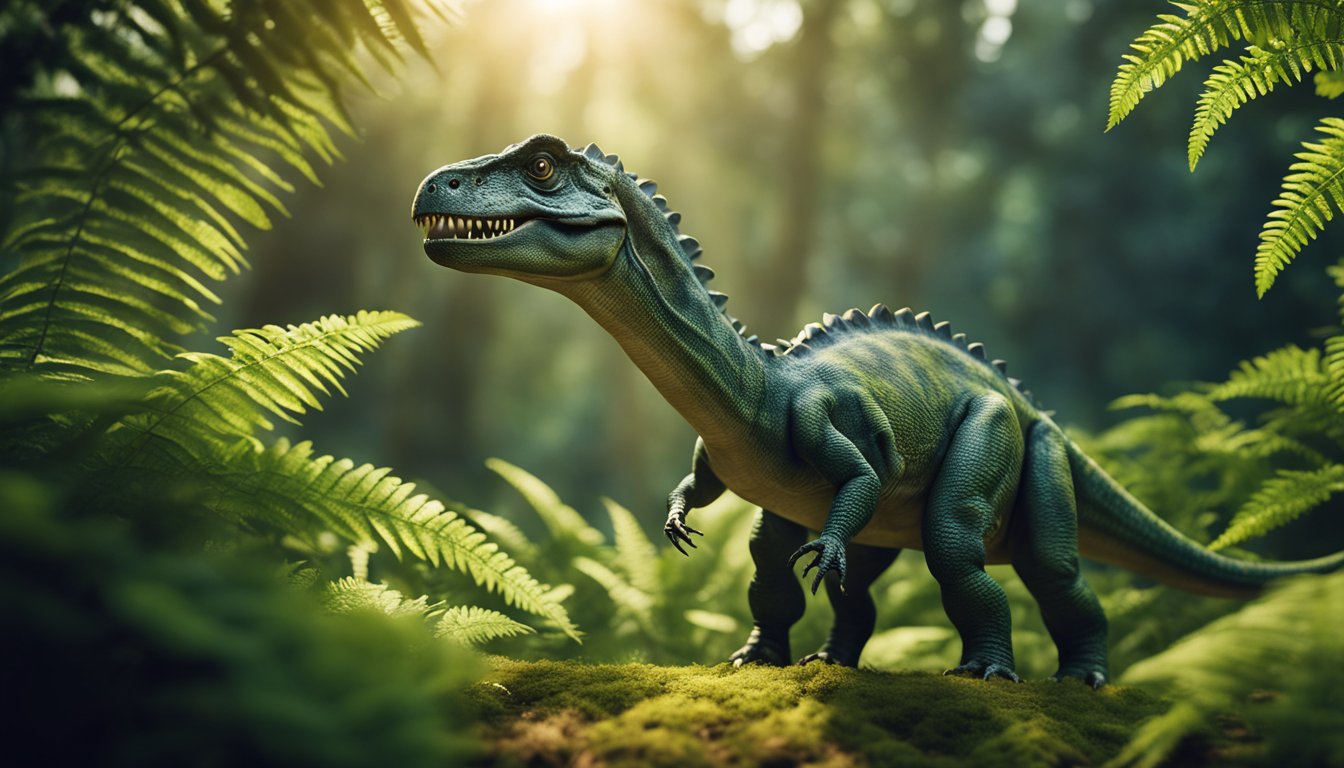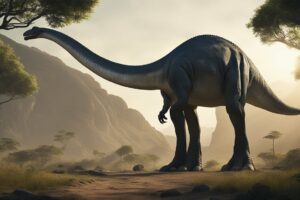Therizinosaurus is a dinosaur that roamed the earth during the Late Cretaceous Period, approximately 70 million years ago.
What makes this dinosaur stand out from the rest is its long claws, which are the longest ever recorded in the animal kingdom.
These claws could grow up to 3 feet in length, making them longer than a samurai sword!

Therizinosaurus was a herbivore, which means it fed on plants.
Its long claws were not used for hunting prey, but rather for gathering vegetation.
The claws were so long that they could reach high branches and pull down leaves, allowing the dinosaur to feed on plants that other herbivores couldn’t reach.
The claws were also used for defense against predators, as they could be used to deliver a powerful swipe.
Despite its impressive size and claws, much about Therizinosaurus remains a mystery.
Scientists have only found a few bones and claws, making it difficult to reconstruct the entire animal.
However, through careful study of these remains, scientists have been able to piece together a picture of what this dinosaur might have looked like and how it lived.
Meet the Therizinosaurus: A Gentle Giant
Therizinosaurus is a herbivorous dinosaur with a unique appearance that sets it apart from other dinosaurs.
Its most notable feature is its incredibly long claws, which are the longest claws of any animal ever discovered.
These claws were not used for hunting, but instead for gathering food and self-defense.
Unraveling the Mystery of Therizinosaurus Size
Therizinosaurus was a large dinosaur, with an estimated length of up to 10 meters (33 feet) and a weight of around 3 tons.
Despite its size, it was a gentle giant that preferred to avoid confrontation and live peacefully among other dinosaurs.
The Vegetation Lover’s Diet
Therizinosaurus was a herbivore, which means it only ate plants.
Its diet consisted mainly of foliage, which it would use its leaf-shaped teeth to chew.
It was known to have a preference for soft vegetation, such as leaves and shoots.
Despite its fearsome appearance, Therizinosaurus was a peaceful dinosaur that preferred to avoid confrontation.
It spent most of its time searching for food and enjoying the company of other herbivorous dinosaurs.
Its long claws were used to help it reach high branches and pull down vegetation, rather than for fighting.
Fun Fact: Therizinosaurus is one of the last known dinosaurs to have lived before the mass extinction event that wiped out the dinosaurs.
Its fossils have been found in Mongolia and China, and its unique appearance has made it a popular subject among paleontologists and dinosaur enthusiasts alike.
The Fearsome Claws: Not for Hunting

Therizinosaurus is a dinosaur known for its incredibly long claws.
These claws are some of the longest ever discovered on any animal, measuring up to two feet in length!
However, despite their intimidating appearance, scientists believe that these claws were not actually used for hunting.
A Closer Look at Claw Structure
If you take a closer look at the structure of the Therizinosaurus claws, you’ll notice that they are not sharp like the claws of a predator.
Instead, they are blunt and curved, more like the claws of a sloth or a tree-dwelling animal.
This suggests that they were not designed for catching prey, but rather for a different purpose.
Defense and Display: The True Purpose
So if the claws weren’t used for hunting, what were they used for?
Scientists believe that there are two possible explanations: defense and display.
Therizinosaurus was a large, herbivorous dinosaur, and it likely faced threats from predators such as Tarbosaurus and Alioramus.
The long claws of the Therizinosaurus may have been used to defend itself against these predators, either by swiping at them or by using the claws to deter them from attacking.
On the other hand, the long claws may have also been used for display.
Many animals, including birds and reptiles, use elaborate displays to attract mates or establish dominance.
The Therizinosaurus may have used its long claws to show off to potential mates or to intimidate rivals.
In addition to defense and display, some scientists believe that the Therizinosaurus may have also used its claws for digging.
The claws are curved and sturdy, which would have made them well-suited for digging up roots and tubers, as well as for creating burrows.
Fascinating Fossils: Piecing Together History

Paleontologists have been studying fossils of this giant theropod dinosaur for decades, and their findings have helped paint a picture of what life was like in Mongolia and Asia during the Late Cretaceous period.
Discoveries Across Mongolia and Asia
Fossils of Therizinosaurus have been discovered in several locations across Mongolia and Asia, including the Gobi Desert and the Nemegt Formation.
These fossils have provided scientists with valuable information about the anatomy and behavior of this unique dinosaur.
One of the most interesting features of Therizinosaurus is its long, curved claws.
These claws could reach lengths of up to one meter, making them the longest claws of any known dinosaur.
Scientists believe that these claws were used for a variety of purposes, including defense, foraging, and even mating.
In addition to its claws, Therizinosaurus had several other unique features that set it apart from other theropod dinosaurs.
It had a long neck, a pot belly, and a beak-like mouth that was adapted for eating plants.
Its broad hips and sturdy legs suggest that it was a slow-moving animal that spent most of its time on the ground.
Connecting with Dinosaur Relatives
Therizinosaurus is part of a group of dinosaurs known as therizinosaurs, which were primarily herbivorous theropods.
These dinosaurs are believed to be closely related to birds, and some scientists even think that they may have had feathers.
Studying fossils of therizinosaurs has helped scientists better understand the evolution of birds and the transition from dinosaurs to birds.
It has also shed light on the diversity of life during the Late Cretaceous period, and the many different types of animals that roamed the Earth at that time.
Therizinosaurus in the Ecosystem

Interactions with Other Dinosaurs
Therizinosaurus was a herbivorous theropod dinosaur that lived during the Late Cretaceous period, approximately 70 to 85 million years ago.
Due to its herbivorous nature, it did not compete with other theropod dinosaurs, which were mostly carnivorous.
Instead, it occupied a different niche in the ecosystem, feeding on leaves, fruits, and other vegetation.
Therizinosaurus may have interacted with other herbivorous dinosaurs, such as sauropods, which were also present during the Late Cretaceous period.
However, there is limited evidence to suggest that Therizinosaurus had any significant interactions with other dinosaurs.
Its long claws may have been used for self-defense against predators, but its large size and herbivorous diet may have made it less vulnerable to attacks.
Adaptations for Survival
Therizinosaurus had several adaptations that helped it survive in its ecosystem.
Its long claws were likely used to reach high branches and pull down vegetation, allowing it to access food that other herbivorous dinosaurs could not reach.
Its long neck and small head also suggest that it had a specialized diet, which may have included tough or hard-to-reach vegetation.
In addition to its physical adaptations, Therizinosaurus may have had other behavioral adaptations that helped it survive.
For example, it may have lived in groups or herds for protection against predators.
It may have also migrated to different areas in search of food or to avoid harsh weather conditions.
Frequently Asked Questions

How long were the claws of the Therizinosaurus, and how did they use them?
The Therizinosaurus had the longest claws of any known animal.
According to A-Z Animals, the claws could reach well over two feet in length.
These claws were sharp and curved, resembling giant scythes.
Despite their size, the claws were surprisingly light, and the dinosaur could move them with great dexterity.
Paleontologists believe that the Therizinosaurus used its claws to strip bark off trees, reach for vegetation, and defend itself from predators.
What other distinctive features did the Therizinosaurus have besides its long claws?
The Therizinosaurus was one of the strangest-looking dinosaurs of all time.
According to the Western Australian Museum, it had broad hips and a pot belly, giving it a rather unusual appearance.
It also had a small head that sat atop a long neck, and a beak-like mouth that it used to snip off vegetation.
Its front legs were much longer than its back legs, and its hind feet had three toes.
Despite its odd appearance, the Therizinosaurus was a formidable creature that could hold its own against some of the largest predators of its time.
How did the Therizinosaurus compare in size to other dinosaurs?
The Therizinosaurus was a large dinosaur, but it was not the biggest.
According to Dinosaur Facts for Kids, it was about 33 feet long, 10 feet tall at the hips, and weighed around 3 tons.
This makes it roughly the same size as a modern-day elephant.
However, it was much lighter than some of the other giant dinosaurs of its time, such as the Argentinosaurus, which weighed up to 100 tons.
Did the Therizinosaurus have feathers, and what does this suggest about its behavior?
Recent studies have suggested that the Therizinosaurus may have had feathers, just like many other dinosaurs of its time.
According to Dinosaur Facts for Kids, fossils of family members have been discovered with imprints of feathers with visible.
These would have been used for insulation and displays. It was certainly too big to fly without large wings, feathers and muscles.
The presence of feathers suggests that the Therizinosaurus was warm-blooded and may have had a higher metabolism than previously thought.
What evidence do paleontologists have that the Therizinosaurus was a real dinosaur?
Paleontologists have found numerous fossils of the Therizinosaurus, including bones, teeth, and claws.
These fossils have been found in various locations around the world, including North America and Asia.
According to Mental Floss, the first fossils of the Therizinosaurus were discovered in Mongolia in the 1940s.
Since then, many more fossils have been found, providing ample evidence that the Therizinosaurus was a real dinosaur that roamed the Earth millions of years ago.
Have scientists discovered a complete Therizinosaurus skeleton, and what can we learn from it?
Unfortunately, scientists have not yet discovered a complete skeleton of the Therizinosaurus.
According to New Dinosaurs, most of the fossils that have been found are incomplete, making it difficult to determine certain aspects of the dinosaur’s anatomy and behavior.
However, even with incomplete fossils, scientists have been able to learn a great deal about the Therizinosaurus, including its size, diet, and distinctive features.
As more fossils are discovered, we may learn even more about this fascinating dinosaur.






